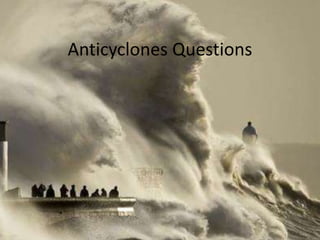
ANTICYCLONES QUESTIONS
- 5. BRITISH ISLES JUNE 2013
- 6. June 2013
- 14. BRITISH ISLES JUNE 2012
- 24. BRITISH ISLES JAN 2011
- 34. OTHERS
- 35. Describe and explain the weather associated with a winter anticyclone in the British Isles. (8 marks)
- 36. Describe and explain the weather associated with a winter anticyclone in the British Isles. (8 marks) Describe Explain Clear skies Descending air, Less RH Calm / light breezes Stable descending air, shallow pressure gradient Cold days Angle incidence, solar footprint, daylight hours Very cold nights No insulation, cold ground, long night time Morning fogs, slow to burn off Temp diff between land and air, fog blocks insolation
- 37. Describe and explain the weather associated with a winter anticyclone in the British Isles. (8 marks) Level 1 (1-4 marks) (mid-point 3) • Simple statements of characteristics/causes, lacking detail or sophistication of either characteristics or processes. Level 2 (5-8 marks) (mid-point 6) • Detailed statements of characteristics and explanation, possibly with some use of supportive material. The answer progresses through the level as more is added at this level. Full mark answers show breadth of knowledge and understanding.
- 38. Explain the characteristic features of the weather associated with a winter anticyclone in the British Isles. (8 marks) Winter weather In winter anticyclones result in: • Cold daytime temperatures – below freezing to a maximum of 5C; • Very cold night-time temperatures – below freezing with frosts; • Clear skies by day and night generally. Low level cloud may linger and radiation fogs (caused by rapid heat loss at night) may remain in low lying areas; • High levels of atmospheric pollution in urban areas, caused by a combination of subsiding air and lack of wind. Pollutants are trapped by a temperature inversion (when air at altitude is marginally warmer than air at lower levels). Some anticyclones are described as being “ blocking ” . Such anticyclones establish themselves over Britain and NW Europe and remain stationary for many days. Depressions which would normally travel across the British Isles on a westerly air stream are steered around the upper edge of the high, and away from the area. Extreme weather conditions are then produced, with dry and freezing weather in winter.
- 39. Explain the characteristic features of the weather associated with a winter anticyclone in the British Isles. (8 marks) Reasons include: • Anticyclones move slowly and may remain stationary over an area for several days and weeks • The air in an anticyclone subsides, that is falls from above. Therefore, this air warms as it falls, producing a decrease in the relative humidity of the air. This in turn leads to a lack of cloud development, and dry conditions • Isobars are usually far apart, and therefore there is little pressure difference between the centre and edges of the anticyclone • Fog may form due to ground temperatures falling below freezing, resulting in a drop in temperatures and with it an increase in relative humidity. The air in contact with the ground will cool first leading to condensation, provided the air is now saturated.
- 40. Explain the variations of the weather experienced under anticyclone conditions
- 41. Explain the variations of the weather experienced under anticyclone conditions (8 marks) Variation Explain Clear skies Both times if year descending air, Less RH Calm / light breezes Stable descending air, shallow pressure gradient Day time temps – quantify Angle of incidence, insolation footprint, daylight hours Night time temps – quantify Both cases no insulation BUT summer – ground stored heat released to sustain higher temp. Fogs / Mist – thickness, duration Freezing air can hold very little moisture so reach saturation far quicker = @ winter
- 42. Explain the variations of the weather experienced under anticyclone conditions • Basic characteristics – Descending air mass due to convergence at altitude – Air gradually moves away from the centre of the High in clockwise direction. – Winds are light – low pressure gradient.
- 43. Explain the variations of the weather experienced under anticyclone conditions Despite these consistent characteristics, the resultant weather varies daily and seasonally. SUMMER TIME Daytime •Insolation heats ground, heats air above – high temps can reach 30oC after prolonged heating •Warm air means greater evaporation and reduce relative humidity so clear skies. •Coastal regions may experience onshore breezes in later parts of the day (diagram to demonstrate) Night time •Lack of cloud cover allows warm air to rise and temperatures drop •Will still remain in the teens – the ground is warmer to a greater depth so is still able to keep the air above it warmer during night time. •However, relative humidity is likely to rise (why?) and this can cause light mist (advection – why?) and dew on the ground (where & why?)
- 44. Explain the variations of the weather experienced under anticyclone conditions WINTER TIME Daytime •Due to low angle of incidence, insolation is spread over larger area so ground does not heat up very much – possibly only a few degrees above freezing. •Clear skies still as colder air is not going to cause as much evaporation so there is less moisture in the atmosphere. Night time •Temperatures drop dramatically as the little heat generated from insolation is quickly lost. •The ground has not been heated to any depth so cooling effect is more dramatic. •Due to air cooling, will reach saturation point resulting in radiation fog – especially in valleys. •Fog may linger for many hours in the morning as the fog absorbs some of the insolation but also reflects it preventing it from reaching and heating the ground which is then unable to heat the air above it (currently saturated) thus clearing the fog. •Sea mist present near coastlines due to advection fog – temp difference between land and sea (due to diff specific heat capacity – energy needed to heat by 1oC)
